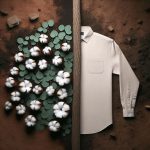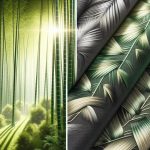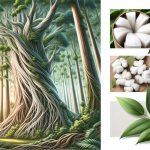Looking to make more sustainable fashion choices? You’re in luck! In this article, we’ll introduce you to eight eco-friendly substitutes for traditional fabric.
From organic cotton and hemp to bamboo and Tencel, these alternatives offer a greener way to dress without compromising on style.
Discover the benefits of linen, recycled polyester, Lyocell, and Piñatex, and start making more conscious choices for a better planet.
Table of Contents
Organic Cotton
If you’re looking for a sustainable fabric option, consider using organic cotton. Not only does it provide numerous benefits, but it also follows best practices for growing cotton.
One of the main advantages of organic cotton is that it’s grown without the use of toxic chemicals, pesticides, or synthetic fertilizers. This makes it safer for farmers, workers, and consumers, as well as for the environment. Organic cotton also promotes biodiversity, as it encourages the growth of beneficial insects and other organisms.
Another benefit of organic cotton is that it requires less water compared to conventional cotton farming. This helps conserve water resources and reduces the strain on local ecosystems. Additionally, organic cotton farming practices focus on soil health and fertility, using techniques such as crop rotation and composting. This helps maintain the long-term productivity of the land and reduces soil erosion.
To grow organic cotton successfully, farmers follow specific best practices. These include selecting suitable varieties of cotton, using natural methods to control pests and diseases, and implementing efficient irrigation systems. They also prioritize organic fertilizers and avoid genetically modified organisms (GMOs). By adhering to these practices, organic cotton farmers ensure the highest quality fabric while minimizing the negative impact on the environment.
Hemp
Hemp is a sustainable alternative to cotton, making it an eco-friendly choice for fabric.
It’s versatile and durable, making it suitable for a wide range of applications.
Sustainable Alternative to Cotton
Consider incorporating hemp as a sustainable alternative to cotton, as it offers numerous environmental benefits. Hemp is a versatile plant that requires minimal water and no pesticides to grow, making it a more sustainable choice compared to cotton. Here are some key points to keep in mind:
-
Benefits of using organic cotton:
-
Organic cotton is grown without the use of harmful chemicals and pesticides, reducing the environmental impact.
-
It’s softer and hypoallergenic, making it ideal for people with sensitive skin.
-
Challenges in the production of sustainable cotton:
-
Conventional cotton production requires large amounts of water and pesticides, leading to soil degradation and water pollution.
-
The demand for cotton has led to deforestation and the displacement of indigenous communities in some regions.
Versatile and Durable Fabric
When looking for a versatile and durable fabric, you’ll find that hemp offers numerous benefits.
Hemp is known for its strength and durability, making it an excellent choice for creating long-lasting clothing.
This versatile fabric can be used to make a variety of clothing items, including shirts, pants, dresses, and even outerwear.
Its durability ensures that your clothing will withstand frequent wear and washing, making it a sustainable option that will last for years to come.
Additionally, hemp fabric is naturally resistant to mold, mildew, and UV rays, making it ideal for outdoor clothing and activities.
Bamboo
Bamboo is a sustainable alternative to traditional fabric that’s gaining popularity in the fashion industry. Its fast-growing nature makes it an eco-friendly choice, as it requires less water and pesticides compared to other crops.
Additionally, bamboo fabric has many benefits, including being hypoallergenic, breathable, and moisture-wicking, making it an excellent choice for clothing.
Sustainable Bamboo Clothing
You can find sustainable clothing made from bamboo. Bamboo clothing offers numerous benefits and is produced using eco-friendly methods. Here are some points to grab your attention:
-
Benefits of Bamboo Clothing:
-
Soft and comfortable: Bamboo fabric is known for its luxurious feel and softness, providing ultimate comfort.
-
Breathable and moisture-wicking: Bamboo clothing allows air circulation, keeping you cool and dry even in hot weather.
-
Hypoallergenic and antibacterial: Bamboo fabric naturally resists bacteria and allergens, making it suitable for sensitive skin.
-
Bamboo Clothing Production Methods:
-
Sustainable growth: Bamboo plants grow rapidly without the need for pesticides or fertilizers, making it an environmentally friendly choice.
-
Low water consumption: Bamboo requires significantly less water compared to traditional cotton farming, conserving precious resources.
Benefits of Bamboo Fabric
Continuing from the previous subtopic, you can now explore the benefits of bamboo fabric, which offers a range of advantages for those seeking eco-friendly alternatives to traditional fabrics.
Bamboo fabric benefits not only the environment but also provides excellent options for eco-friendly clothing. One of the key advantages of bamboo fabric is its sustainability. Bamboo is a rapidly renewable resource that grows without the need for pesticides or fertilizers. This makes it an excellent choice for those who want to reduce their ecological footprint.
Additionally, bamboo fabric is naturally hypoallergenic and has moisture-wicking properties, making it perfect for sensitive skin and hot climates. It’s also known for its breathability and softness, providing comfort and style in eco-friendly clothing options.
Tencel
One alternative to traditional fabric that’s eco-friendly and sustainable is Tencel, which is made from wood pulp and manufactured using a closed-loop process. Tencel has several benefits and its production process contributes to its eco-friendly nature.
Benefits of Tencel:
- Soft and breathable: Tencel fabric feels incredibly soft against the skin and has excellent moisture-wicking properties, keeping you cool and dry.
- Environmentally friendly: Tencel is derived from renewable wood sources, making it a sustainable choice. Its production process also uses less water and energy compared to traditional fabrics.
- Biodegradable: Tencel is fully biodegradable, meaning it can naturally decompose without leaving behind harmful waste.
Tencel production process:
- Closed-loop system: The production of Tencel involves a closed-loop system, where the solvent used to dissolve the wood pulp is recycled and reused. This reduces waste and minimizes the environmental impact.
- Low chemical usage: The production process of Tencel uses non-toxic chemicals, such as amine oxide, which is safe for both the environment and workers.
Linen
As we delve into the eco-friendly alternatives to traditional fabric, let’s explore the qualities of linen, a sustainable option that seamlessly builds upon the previous discussion.
Linen is a natural fiber made from the flax plant. It’s highly regarded for its durability, breathability, and moisture-wicking properties. One of the benefits of linen is that it’s biodegradable, making it an excellent choice for those concerned about the environmental impact of their clothing choices.
Linen clothing brands are becoming increasingly popular as people look for sustainable and eco-friendly options. These brands prioritize ethical sourcing and production methods, ensuring that their linen garments are made with minimal environmental impact. Some well-known linen clothing brands include EILEEN FISHER, a company committed to sustainable practices, and Amour Vert, which focuses on using organic materials.
Wearing linen not only benefits the environment but also offers numerous advantages to the wearer. Linen is highly breathable, making it perfect for warm weather. Its moisture-wicking properties help keep you cool and dry. Additionally, linen is hypoallergenic and naturally antibacterial, making it a great choice for those with sensitive skin.
Recycled Polyester
To embrace eco-friendly alternatives to traditional fabric, consider incorporating recycled polyester into your wardrobe. Recycled polyester is a sustainable option that offers several benefits over traditional polyester:
-
Environmental benefits:
-
Reduces the demand for new petroleum-based polyester production, which helps conserve natural resources.
-
Decreases the amount of plastic waste in landfills and oceans, as recycled polyester is made from post-consumer plastic bottles.
-
Energy and carbon footprint reduction:
-
The production of recycled polyester requires less energy and emits fewer greenhouse gases compared to traditional polyester.
-
By choosing recycled polyester, you contribute to the reduction of carbon emissions and combat climate change.
In terms of comparison, recycled polyester is similar to traditional polyester in terms of durability, versatility, and cost. However, it has the added advantage of being more sustainable. By choosing recycled polyester, you can actively contribute to a cleaner and greener future.
Lyocell
Consider incorporating lyocell, a sustainable fabric option, into your wardrobe for its numerous environmental benefits.
Lyocell is an eco-friendly fabric made from wood pulp, typically sourced from fast-growing trees such as bamboo. It’s known for its softness, breathability, and durability, making it an excellent choice for sustainable clothing.
Lyocell is produced using a closed-loop system, which means that the chemicals used in the manufacturing process are recycled and reused, minimizing waste and reducing environmental impact. Unlike traditional fabrics, lyocell doesn’t require extensive use of water or harmful chemicals, making it a more sustainable alternative.
In addition to its eco-friendly production process, lyocell is also biodegradable, meaning that it can naturally decompose without causing harm to the environment. This makes it a great choice for those looking for organic alternatives in the sustainable fashion industry.
With the growing demand for eco-friendly substitutes, lyocell has gained popularity in the fashion industry. It’s used in a wide range of products, including clothing, accessories, and home textiles. Its versatility and sustainability make it a preferred choice for many designers and consumers who are conscious of their environmental footprint.
By choosing lyocell, you aren’t only supporting the use of eco-friendly materials but also contributing to the growth of the sustainable fashion industry.
Piñatex
One alternative to traditional fabric that you should explore is Piñatex, an eco-friendly material made from pineapple leaf fibers. Piñatex production involves extracting the fibers from pineapple leaves, which are typically discarded after harvesting the fruit. This process not only reduces waste but also provides additional income for pineapple farmers.
When it comes to the environmental impact of Piñatex, it has several benefits. Here are some key points to consider:
- Reduced water consumption: Piñatex requires significantly less water compared to traditional fabric production, making it a more sustainable choice.
- Minimal use of pesticides: Pineapple plants are generally resistant to pests, which means that fewer pesticides are needed during cultivation, reducing chemical pollution.
- Biodegradable and compostable: Piñatex is biodegradable, meaning it can naturally break down over time without causing harm to the environment. It can also be composted, further reducing waste.
- Reduced carbon footprint: By utilizing pineapple leaf fibers that would otherwise be discarded, Piñatex helps reduce the need for additional resources and energy-intensive processes, resulting in a lower carbon footprint.
Frequently Asked Questions
Are These Eco-Friendly Fabrics as Durable and Long-Lasting as Traditional Fabrics?
Yes, eco-friendly fabrics can be as durable and long-lasting as traditional fabrics. They are also produced with less environmental impact and although their prices may vary, they offer a sustainable alternative.
Can These Eco-Friendly Fabrics Be Easily Incorporated Into My Existing Wardrobe?
Yes, incorporating fashion forward eco friendly fabric options into your existing wardrobe is easier than you think. Transitioning to an eco friendly wardrobe is a stylish and sustainable choice that can be achieved with these substitutes.
Do These Fabrics Require Any Special Care or Maintenance?
Do these fabrics require any special care or maintenance? Yes, some eco-friendly fabrics may require specific care instructions to maintain their durability. However, they are generally long-lasting and can easily be incorporated into your existing wardrobe.
Are There Any Specific Certifications or Labels to Look for When Purchasing These Eco-Friendly Fabrics?
When purchasing eco-friendly fabrics, look for certifications like Global Organic Textile Standard (GOTS) or OEKO-TEX Standard 100. These labels ensure that the fabrics meet certain environmental and social criteria. Compare their impact to traditional fabrics.
Are There Any Potential Drawbacks or Limitations to Using These Eco-Friendly Fabrics in Terms of Style or Versatility?
When it comes to eco-friendly fabrics, there might be potential challenges in terms of style or versatility. However, with the right fashion trends and creative approach, you can still showcase your personal style and contribute to a sustainable future.
- Fabrics and Their Role in Wellness and Comfort - July 22, 2024
- Choosing Safe Fabrics for Baby Clothes - July 22, 2024
- Impact of Fabrics on Skin Health - July 22, 2024







